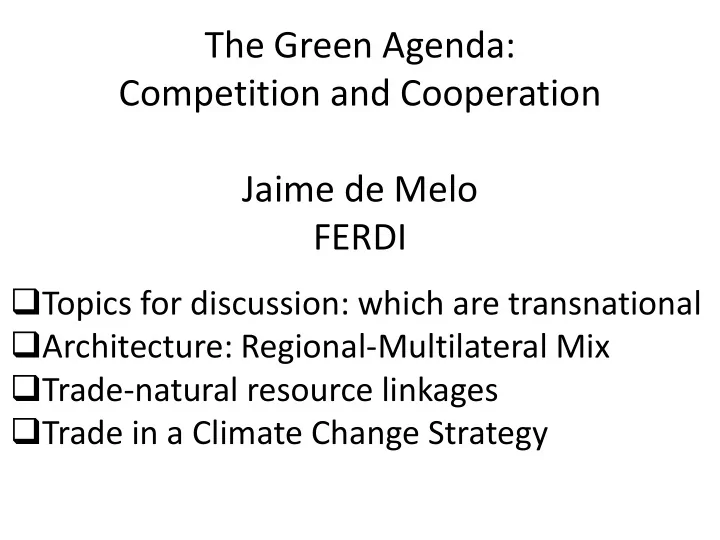

The Green Agenda: Competition and Cooperation Jaime de Melo FERDI Topics for discussion: which are transnational Architecture: Regional-Multilateral Mix Trade-natural resource linkages Trade in a Climate Change Strategy
Topics for Discussion: Which are transnational? Current growth patterns are not sustainable and those concerned not at the table. Extraordinarily difficult political economy problem. Bruntland (1996) «We knew the basic priniciples on which to build: cost effectiveness, equity, joint implementation, and comprehensiveness. But not how to build». Today problem is still «getting prices right» but political economy complicates (acceptability as costs are immediate and visible while benefits diffuse; missing markets (who pays the electricty bill, etc…) Many among these long-term problems are national (land use planning to prevent urban sprawl)
Which Architecture: Regional-Multilateral Mix Architecture for Global Policy Making of current triad (IMF, World Bank, WTO) needs to reflect world with stronger physical linkages. Is MFN + NT best compromise to face the threat of carbon tariffs and Border tax adjustments (BTAs). BTAs have lower discriminatory capacity than contingent protection (developing countries want MFN, developed NT). Subsidy rules at the WTO. We need subsidies for specific types of energy (not generic). Yearly subsidies. Fossil fuels : [$450 billion]; water [$250 billion]; Fisheries [$20 billion ]; transfers to agriculture: [$370 billion] A regional approach with leeway (i.e. bottom-up approach) more likely to give results (GATT with leeway «live and let live» more successful than WTO with SU). Many environmental directives under Maastricht have fared well . Vladisvostok initiative works in that direction (see later).
Trade-Natural Resource Linkages Trade-related Pressures on Natural Resources Most natural resources are very concentrated in low-income countries with weak institutional environments. Opening to trade: price no longer regulates (given from outside) so open access problems exacerbated. How to to preserve environement and trade (raw materials & rare earths in China; palm oil in Indonesia and Malaysia; Forests in Vietnam ) Trade country worse-off (loss of natural capital) especially if replenishment rate is low and population is large. A multilateral problem (few concrete steps yet taken to preserve biodiversity). Any role for regional approach?
Trade in a Climate Change Strategy Climate is the ‘ perfect ’ global public good. What role for 1. trade (given that it cannot establish property rights)? Portfolio of green technologies carbon-free necessary 2. and it will require huge R&D effort (private and public). Open WTS needed to diffuse technological progress Any role for threat of trade sanctions as under Montreal 3. protocol to entice participation (deter ‘free -riding ’). What about building confidence with sector treaties (e.g. aluminimum) perhaps at regional level? Large differences in abatement costs: separate where 4. abatement takes place from who pays the costs (carbon- credit trading system as in e.g. ETS). Carbon-motivated free-trade area (EA,EU-EA?). Lessons of EU for East Asia?
Recommend
More recommend